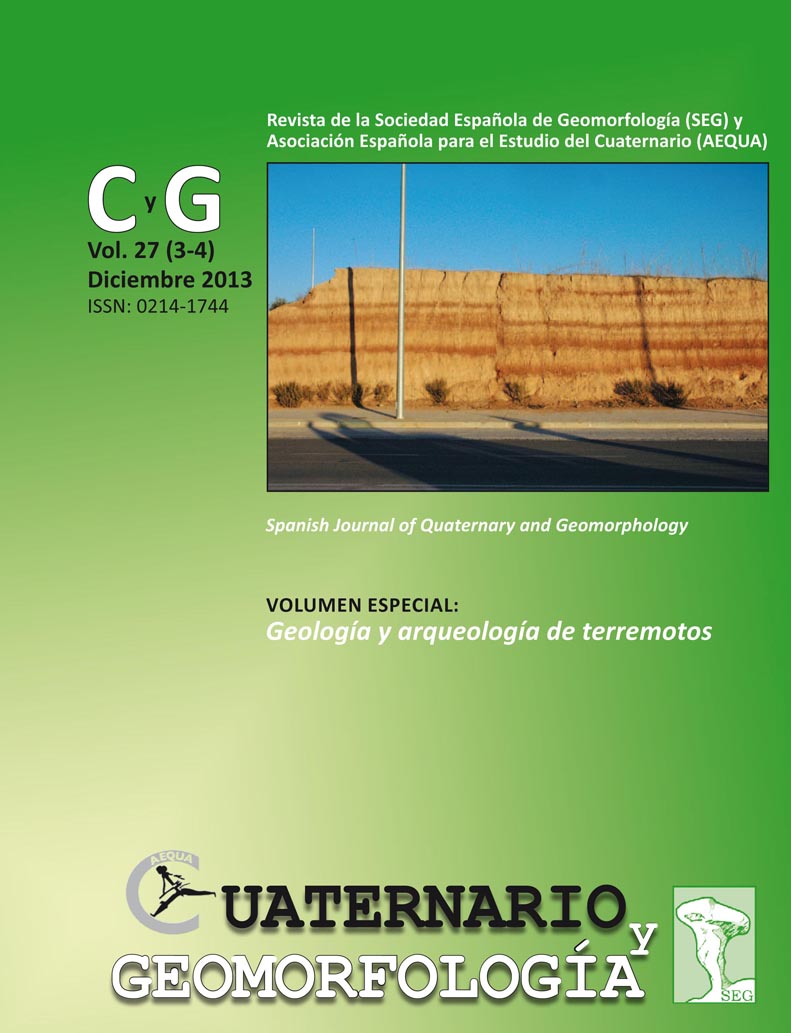Análisis de caídas orientadas de estructuras (efecto arqueológico de terremotos) inducidas por terremotos instrumentales
Palabras clave:
efectos arqueológicos de terremotos (EAEs), caídas orientadas de estructuras, terremotos de Christchurch, terremoto de Lorca, terremotos de Emilia RomagnaResumen
Las caídas orientadas de estructuras en yacimientos arqueológicos (e.g. columnas, obeliscos) se han utilizado como indicadores de actividad sísmica. Sin embargo, su interpretación ha sido siempre controvertida, especialmente con respecto a la influencia de las características de las estructuras en los daños que registran (calidad de la construcción, conservación, etc.) en relación a la orientación de colapso. En este trabajo se analizan las caídas orientadas de estructuras asociadas a tres series sísmicas instrumentales con intensidades ≥ VII EMS: terremoto de Lorca, España (11/05/2011); secuencias sísmicas de Christchurch, Nueva Zelanda (04/09/2010 y 22/02/2011) y series sísmicas de Emilia Romagna, Italia (20/05/2012 y 29/05/2012). Los datos cuantitativos obtenidos en este trabajo revelan la coherencia de las orientaciones de las estructuras de colapso con respecto a la localización de los epicentros, independientemente de su edad, tipo y estado de conservación. La dirección de llegada de las ondas sísmicas en terremotos de campo cercano provoca caídas con orientaciones subparalelas y consistentes con otras orientaciones de daños. No obstante en yacimientos arqueológicos es necesario evaluar otras posibles causas de origen de los daños.
Descargas
Citas
Ambraseys, E. (2006). Earthquakes and archaeology. Journal of Archaeological Science, 33: 1008-1016.
Giner-Robles, J.L.; Rodríguez-Pascua, M.A.; Pérez-López, R.; Silva, P.G.; Bardají, T.; Grützner C. y Reicherter, K. (2009). Structural analysis of Earthquake Archaeological Effects (EAE) Baelo Claudia Examples (Cádiz, South Spain), 137 pp.
Giner-Robles, J.L.; Silva Barroso, P.G.; Pérez-López, R.; Rodríguez-Pascua, M.A.; Bardají Azcárate, T.; Garduño-Monroy, V.H. y Lario Gómez, J. (2011). Evaluación del daño sísmico en edificios históricos y yacimientos arqueológicos. Aplicación al estudio del riesgo sísmico. Proyecto EDASI”. Serie Investigación. Fundación MAPFRE, 96 pp.
Giner-Robles, J.L.; Pérez-López, R., Rodríguez-Pascua, M.A.; Silva Barroso, P.G.; Martín-González, F., Cabañas, L. (2012). Oriented Structural analysis of seismically oriented damage caused by the Lorca earthquake of 11 May 2011: Application to archaeoseismology. Boletín Geológico y Minero, 123, 4, 503-513.
Hinzen, K.G. (2009).Dynamic response of simple structures. In: R. Pérez-López, C. Grützner, J. Lario, K. Reicherter and P.G. Silva (eds). Archaeoseismology and Palaeoseismology in the Alpine-Himalayan Collisional Zone. Proceedings 1st INQUA-IGCP 567 International Workshop on Earthquake Archaeology and Palaeoseismology. Baelo Claudia, Spain. pp 47-49.
Hinzen, K.G., Fleischer, C., Reamer, S.K., Schreiber, S., Schütte, S. and Yerli, B. (2009). Quantitative methods in archaeoseismology. In: R. Pérez-López, C. Grützner, J. Lario, K. Reicherter and P.G. Silva (eds). Archaeoseismology and Palaeoseismology in the Alpine-Himalayan Collisional Zone. Proceedings 1st INQUA-IGCP 567 International Workshop on Earthquake Archaeology and Palaeoseismology, Baelo Claudia, Spain. pp. 50-51.
IGME (2011). Informe geológico preliminar del Terremoto de Lorca del 11 de mayo de 2011 Mw 5.1. IGME, Madrid (Spain). 47 pp.
IGN (2012). Informe del sismo de Lorca del 11 de mayo de 2011. IGN, Madrid (Spain). 129 pp
ISPRA (2012). Geological effects induced by the seismic sequence started on may 20, 2012, in Emilia (Mw=5.9). Preliminary Report. Open file report. Servizo Geologico d´Italia. 10pp.
Lavecchia, G., de Nardis, R., Cirillo, D., Brozzetti, F., Boncio, P. (2012). The May-June 2012 Ferrara Arc earthquakes (northern Italy): structural control of the spatial evolution of the seismic sequence and of the surface pattern of coseismic fractures. Annals of Geophysics, 4, 533-540
Marco, S. (2008). Recognition of earthquake-related damage in archaeological sites: Examples from the Dead Sea fault zone. Tectonophysics, 453, 148-156.
Martínez-Díaz, J.J., Bejar, M., Álvarez-Gómez, J.A., Mancilla, F., Stich, D., Herrera, G., Morales, J. (2012). Tectonic and seismic implications of an intersegment rupture. The damaging May 11th 2011 Mw 5.2 Lorca, Spain, earthquake. Tectonophysics. 546-547, 28-37.
Martínez Solares, J.M., Cantavella Nadal, J.V., Cabañas Rodríguez, L., Valero Zornosa, J.F. (2012). El terremoto de Lorca de 11 de mayo de 2011 y la sismicidad de la región. Física de la Tierra, 24, 17-40.
Nur, A. and Ron, H. (1996). And the Walls Came Tumbling Down: Earthquake History in the Holyland. In: Stiros and Jones, Archaeoseismology. Fitch Laboratory Occasional Paper, 7. British School at Athens. pp. 75-86.
Pérez-López, R., Giner-Robles, J.L., Rodríguez-Pascua, Miguel A., Martín-González, F.and Silva, Pablo G. (2012). Discussing the seismogenic source for the Emilia Romagna seismic series (May 2012, Italy) from oriented damage and EAE´s analysis. In: Proceedings 3rd INQUA-IGCP-567 International Workshop on Active Tectonics, Paleoseismology and Archaeoseismology, Morelia, Mexico. pp. 125-130.
Rodríguez-Pascua, M.A., Pérez-López, R., Silva, P.G., Giner-Robles, J.L., Garduño-Monroy, V.H., y Reicherter, K. (2011). A Comprehensive Classification of Earthquake Archaeological Effects (EAE) for Archaeoseismology. Quaternary International, 242, 20-30.
Rodríguez-Pascua, M.A., Pérez-López, R., Giner-Robles, J.L., Silva, P.G., Garduño-Monroy, V.H., y Reicherter, K. (2009). A comprehensive classification of Earthquake Archaeological Effects (EAE) for structural strain analysis in archaeoseismology. Proceedings 1st INQUA-IGCP 567 International Workshop on Earthquake Archaeology and Palaeoseismology, Baelo Claudia, Spain. pp. 114-118.
Silva, P.G., Reicherter, K., Grützner, Ch., Bardají, T., Lario, J., Goy, J.L., Zazo, C. and Becker-Heidmann, P. (2009). Surface and subsurface palaeoseismic records at the ancient Roman city of Baelo Claudia and the Bolonia Bay area, Cádiz (south Spain). Geological Society of London, Spc. Pub., 316, 93-121.
Stiros, S. C. (1996). Identification of Earthquakes from Archaeological Data: Methodology, Criteria and Limitations. In: Archaeoseismology (Stiros, S. and Jones, R. eds). Fitch Laboratory Occasional Paper, 7. British School at Athens. pp. 129-152.


